Low Cycle Fatigue Properties of Sc-Modified AA2519-T62 Extrusion
Abstract
1. Introduction
2. Materials and Methods
3. Results and Discussion
4. Conclusions
- The investigated material has three stages of cyclic life: a very short period of cyclic hardening, cyclic stabilization and a final rapid drop in stress amplitude value until failure. Together with increasing strain amplitude, the stage of cyclic stabilization disappears, and for the highest value of amplitude (0.8%), it is impossible to distinguish.
- The obtained results allowed to establish Ramberg-Osgood and Manson-Coffin-Basquin relationships. The established values of the cyclic strength coefficient and cyclic strain hardening exponent equal to k’ = 1518.1 MPa and n’ = 0.1702. For the Manscon-Coffin-Basquin equation, the values of the following parameters have been established: the fatigue strength coefficient σ’f = 1489.8 MPa, the fatigue strength exponent b = −0.157, the fatigue ductility coefficient ε’f = 0.4931 and the fatigue ductility exponent c = −1.01.
- The scanning electron microscopy observations of the fractures revealed the presence of cracks in striations in the surrounding area with a high concentration of precipitates. Additionally, it has been reported that larger Al2Cu precipitates exhibit a higher tendency to fracture than smaller precipitates having an elevated concentration of scandium and zirconium.
Author Contributions
Funding
Conflicts of Interest
References
- Hirsch, J. Aluminium Alloys for Automotive Application. Mater. Sci. Forum 1997, 242, 33–50. [Google Scholar] [CrossRef]
- Starke, E.A.; Staley, J.T. Application of Modern Aluminum Alloys to Aircraft. Prog. Aerosp. Sci. 1996, 32, 131–172. [Google Scholar] [CrossRef]
- Mierzyński, J.; Hutsaylyuk, V. Fatigue Crack Growth in the D16CzATW Aluminium Alloy in the Presence of a Calibrated Hole under Simple Bending. Int. J. Fatigue 2012, 39, 54–60. [Google Scholar] [CrossRef]
- Kaushik, Y.; Jawalkar, C.S. A Review on Use of Aluminium Alloys in Aircraft Components. i-Manager’s J. Mater. Sci. 2015, 3, 33–38. [Google Scholar]
- Gloria, A.; Montanari, R.; Richetta, M.; Varone, A. Alloys for Aeronautic Applications: State of the Art and Perspectives. Metals. 2019, 9, 662. [Google Scholar] [CrossRef]
- Kurzydłowski, K.J. Microstructural Refinement and Properties of Metals Processed by Severe Plastic Deformation. Bull. Pol. Acad. Sci., Tech. Sci. 2004, 52, 301–311. [Google Scholar]
- Kulczyk, M.; Przybysz, S.; Skiba, J.; Pachla, W. Severe Plastic Deformation Induced in Al, Al-Si, Ag and Cu by Hydrostatic Extrusion. Arch. Metall. Mater. 2014, 59, 59–64. [Google Scholar] [CrossRef]
- Olejnik, L.; Kulczyk, M.; Pachla, W.; Rosochowski, A. Hydrostatic Extrusion of UFG Aluminium. Int. J. Mater. Form. 2009, 2, 621–624. [Google Scholar] [CrossRef]
- Okeke, U.; Yilmazer, H.; Sato, S.; Boehlert, C. Strength Enhancement of an Aluminum Alloy through High Pressure Torsion. Mater. Sci. Eng. A-Struct. 2019, 760, 195–205. [Google Scholar] [CrossRef]
- Harsha, R.N.; Mithun Kulkarni, V.; Satish Babu, B. Severe Plastic Deformation - A Review. Mater. Today: Proc. 2018, 5, 22340–22349. [Google Scholar] [CrossRef]
- Chen, X.; Huang, G.; Liu, S.; Han, T.; Jiang, B.; Tang, A.; Zhu, T.; Pan, F. Grain Refinement and Mechanical Properties of Pure Aluminum Processed by Accumulative Extrusion Bonding. Trans. Nonferrous Met. Soc. China 2019, 29, 437–447. [Google Scholar] [CrossRef]
- Arigela, V.G.; Palukuri, N.R.; Singh, D.; Kolli, S.K.; Jayaganthan, R.; Chekhonin, P.; Scharnweber, J.; Skrotzki, W. Evolution of Microstructure and Mechanical Properties in 2014 and 6063 Similar and Dissimilar Aluminium Alloy Laminates Produced by Accumulative Roll Bonding. J. Alloy Compd. 2019, 790, 917–927. [Google Scholar] [CrossRef]
- Zuiko, I.; Gazizov, M.; Kaibyshev, R. Effect of Cold Plastic Deformation on Mechanical Properties of Aluminum Alloy 2519 After Ageing. Mater. Sci. Forum 2014, 794–796, 888–893. [Google Scholar] [CrossRef]
- Azimi, A.; Owolabi, G.M.; Fallahdoost, H.; Kumar, N.; Warner, G. High Strain Rate Behavior of Ultrafine Grained AA2519 Processed via Multi Axial Cryogenic Forging. Metals 2019, 9, 115. [Google Scholar] [CrossRef]
- Shaban, M.; Gozalzadeh, S.; Eghbali, B. Plastic Deformation of 7075 Aluminum Alloy Using Integrated Extrusion - Equal Channel Angular Pressing. J. Adv. Mater. Process. 2016, 4, 30–37. [Google Scholar]
- Davydov, V.G.; Elagin, V.I.; Zakharov, V.V.; Rostova, T.D. Alloying Aluminium Alloys with Scandium and Zirconium Additives. Met. Sci. Heat Treat. 1996, 38, 347–352. [Google Scholar] [CrossRef]
- Zakharov, V.V. Effect of Scandium on the Structure and Properties of Aluminium Alloys. Met. Sci. Heat Treat. 2003, 45, 246. [Google Scholar] [CrossRef]
- Jia, Z.H.; Røyset, J.; Solberg, J.K.; Liu, Q. Formation of Precipitates and Recrystallization Resistance in Al-Sc-Zr Alloys. Trans. Nonferrous Met. Soc. China 2012, 22, 1866–1871. [Google Scholar] [CrossRef]
- Røyset, J.; Ryum, N. Scandium in Aluminium Alloys. Int. Mater. Rev. 2005, 50, 19–44. [Google Scholar] [CrossRef]
- Jia, Z.H.; Huang, H.L.; Wang, X.L. Hafnium in Aluminum Alloys: A Review. Acta Metall. Sin. 2016, 29, 105. [Google Scholar] [CrossRef]
- Håkon, H. Precipitation Behaviour and Recrystallisation Resistance in Aluminum Alloys with Additions of Hafnium, Scandium and Zirconium. Ph.D. Thesis, The Norwegian University of Science and Technology, Trondheim, Norway, 2005. [Google Scholar]
- Long, S.Y. Progress in Light Metals, Aerospace Materials and Superconductors; Trans Tech Publications, Ltd.: Zürich, Switzerland, 2007. [Google Scholar]
- Nokhrin, A.; Shadrina, I.; Chuvil’deev, V.; Kopylov, V. Study of Structure and Mechanical Properties of Fine-Grained Aluminum Alloys Al-0.6wt.%Mg-Zr-Sc with Ratio Zr:Sc = 1.5 Obtained by Cold Drawing. Materials 2019, 12, 316. [Google Scholar] [CrossRef] [PubMed]
- Koutny, D.; Skulina, D.; Pantělejev, L.; Paloušek, D.; Lenczowski, B.; Palm, F.; Nick, A. Processing of Al-Sc Aluminum Alloy Using SLM Technology. Procedia CIRP 2018, 74, 44–48. [Google Scholar] [CrossRef]
- Mogucheva, A.; Kaibyshev, R. Microstructure and Mechanical Properties of an Al-Li-Mg-Sc-Zr Alloy Subjected to ECAP. Metals 2016, 6, 254. [Google Scholar] [CrossRef]
- Sun, Y.; Song, M.; He, Y. Effects of Sc Content on the Mechanical Properties of Al-Sc Alloys. Rare Met. 2010, 29, 451. [Google Scholar] [CrossRef]
- Hutsaylyuk, V.; Sniezek, L.; Chausov, M.; Torzewski, J.; Pylypenko, A.; Wachowski, M. Cyclic Deformation of Aluminium Alloys after the Preliminary Combined Loading. Eng. Fail. Anal. 2016, 69, 66–76. [Google Scholar] [CrossRef]
- Hutsaylyuk, V.; Sniezek, L.; Torzewski, J.; Chausov, M.; Berezin, V.; Pylypenko, A. Influence of Preliminary Combined Loading on Low Cyclic Fatigue Deformation of Aluminum Alloy D16ChATV. Procedia Eng. 2015, 114, 18–25. [Google Scholar] [CrossRef][Green Version]
- Wachowski, M.; Sniezek, L.; Szachogluchowicz, I.; Kosturek, R.; Płociński, T. Microstructure and Fatigue life of Cp-Ti/316L Bimetallic Joints Obtained by Means of Explosive Welding. Bull. Pol. Acad. Sci., Tech. Sci. 2018, 66, 925–933. [Google Scholar] [CrossRef]
- Badaruddin, M.; Supriadi, H. Low Cycle Fatigue Properties of Extruded 6061-T6 Aluminum Alloy. J. Phys. Conf. Ser. 2019, 1198, 032002. [Google Scholar] [CrossRef]
- Sharma, V.; Rao, S.; Sharma, S.C.; George, K. Low Cycle Fatigue Behavior of AA2219-T87 at Room Temperature. Mater. Perform. Charact. 2014, 3, 103–126. [Google Scholar] [CrossRef]
- Zhao, X.; Li, H.; Chen, T.; Cao, B.; Li, X. Mechanical Properties of Aluminum Alloys under Low-Cycle Fatigue Loading. Materials 2019, 12, 2064. [Google Scholar] [CrossRef]
- Kosturek, R.; Śnieżek, L.; Torzewski, J.; Wachowski, M. Research on the Friction Stir Welding of Sc-Modified AA2519 Extrusion. Metals 2019, 9, 1024. [Google Scholar] [CrossRef]
- Kosturek, R.; Śnieżek, L.; Wachowski, M.; Torzewski, J. The Influence of Post-Weld Heat Treatment on the Microstructure and Fatigue Properties of Sc-Modified AA2519 Friction Stir-Welded Joint. Materials 2019, 12, 583. [Google Scholar] [CrossRef] [PubMed]
- Wachowski, M.; Kosturek, R.; Sniezek, L.; Mróz, S.; Gloc, M.; Krawczyńska, A.; Malek, M. Analysis of the Microstructure of an AZ31/AA1050/AA2519 Laminate Produced Using the Explosive-Welding Method. Materiali Tehnol. 2019, 53, 239–243. [Google Scholar] [CrossRef]
- Szachogluchowicz, I.; Sniezek, L.; Hutsaylyuk, V. Low Cycle Fatigue Properties of AA2519-Ti6Al4V Laminate Bonded by Explosion Welding. Eng. Fail. Anal. 2016, 69, 77–87. [Google Scholar] [CrossRef]
- Fisher, J.; James, J. Aluminum Alloy 2519 in Military Vehicles. Mater. Sci. Forum 2002, 160, 43–46. [Google Scholar]
- Wu, Y.P.; Ye, L.Y.; Jia, Y.; Liu, L.; Zhang, X.M. Precipitation Kinetics of 2519A Aluminum Alloy Based on Aging Curves and DSC Analysis. Trans. Nonferrous Met. Soc. China 2014, 24, 3076–3083. [Google Scholar] [CrossRef]
- Mathe, J.W. Precipitate Coarsening during Overaging of 2519 Al-Cu Alloy: Application to Superplastic Processing; Institutional Archive of the Naval Postgraduate School: Monterey, CA, USA, 1992. [Google Scholar]
- Rozumek, D.; Marciniak, Z. Fatigue Crack Growth in AlCu4Mg1 under Nonproportional Bending-with-Torsion Loading. Mat. Sci. 2011, 46, 685–694. [Google Scholar] [CrossRef]
- Mayer, H.; Schuller, R.; Fitzka, M. Fatigue of 2024-T351 Aluminium Alloy at Different Load Ratios up to 1010 Cycles. Int. J. Fatigue 2013, 57, 113–119. [Google Scholar] [CrossRef]
- Marcisz, E.; Rozumek, D.; Marciniak, Z. Influence of Control Parameters on the Crack Paths in the Aluminum Alloy 2024 under Bending. Frattura ed Integrita Strutturale 2015, 9, 379–386. [Google Scholar] [CrossRef]
- Owolabi, G.; Thom, M.; Ajide, O.; Azimi, A.; Whitworth, H.; Warner, G. Fatigue Responses of Three AA 2000 Series Aluminum Alloys. J. Mater. Sci. Chem. Eng. 2019, 7, 32–48. [Google Scholar] [CrossRef]
- Mohamed, A.; El-Madhoun, Y.; Bassim, M.N. The Effect of Grain Size on Low-Cycle Fatigue Behavior of Al-2024 Polycrystalline Alloy. Metall. Mat. Trans. A 2004, 35, 2725. [Google Scholar] [CrossRef]
- Sniezek, L.; Malachowski, J. Analysis of Stress and Strain Concentrations in Notched Members Made of Alloys D16 and 1460. Tech. Sci. 2006, 9, 93–109. [Google Scholar]
- Baek, U.B.; Park, J.S.; Chung, I.H.; Nahm, S.H.; Ma, Y.H.; Lee, Y.Y. A Study on Fatigue Properties of Sc Added Al 2519 Alloy. Key Eng. Mat. 2005, 297–300, 2483–2488. [Google Scholar] [CrossRef]
- Peč, M.; Zapletal, J.; Šebek, F.; Petruška, J. Low-Cycle Fatigue, Fractography and Life Assessment of EN AW 2024-T351 under Various Loadings. Exp. Tech. 2018, 43. [Google Scholar] [CrossRef]
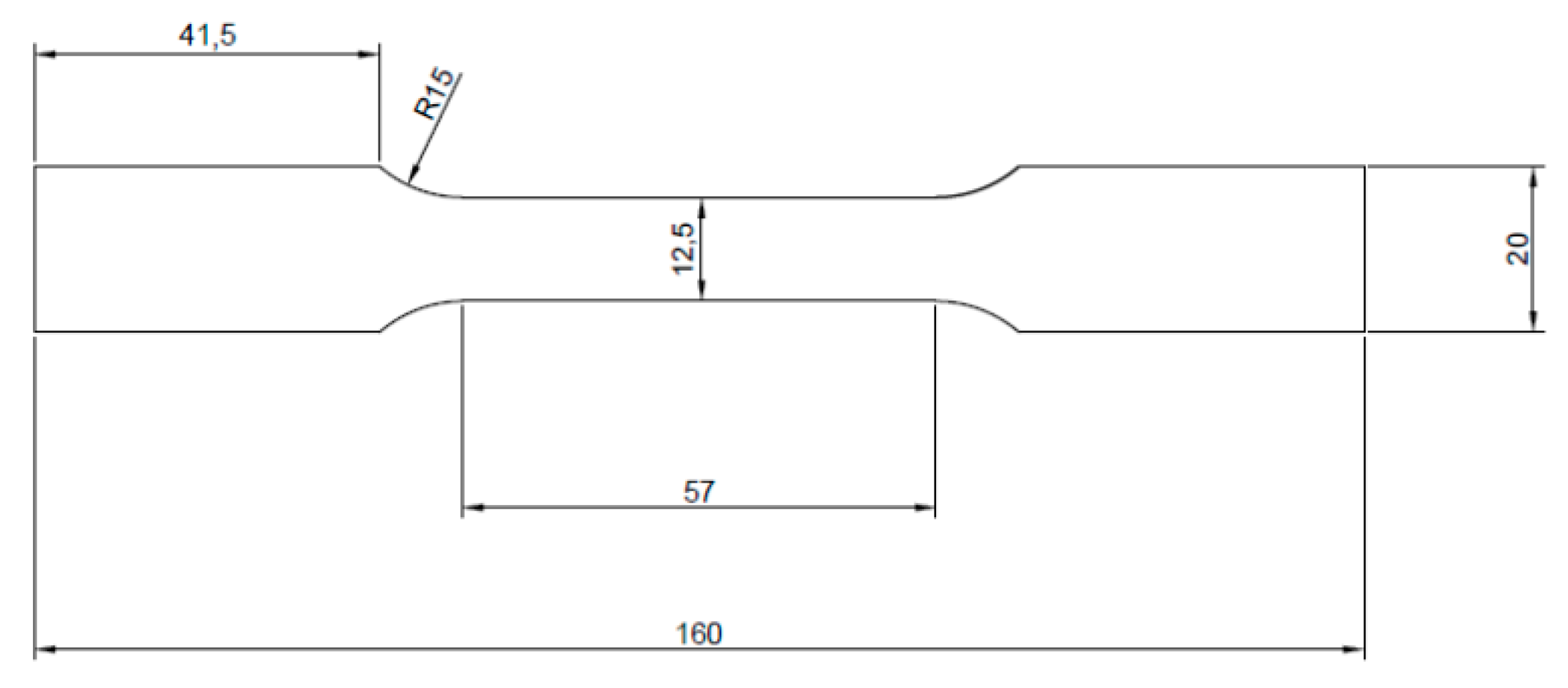
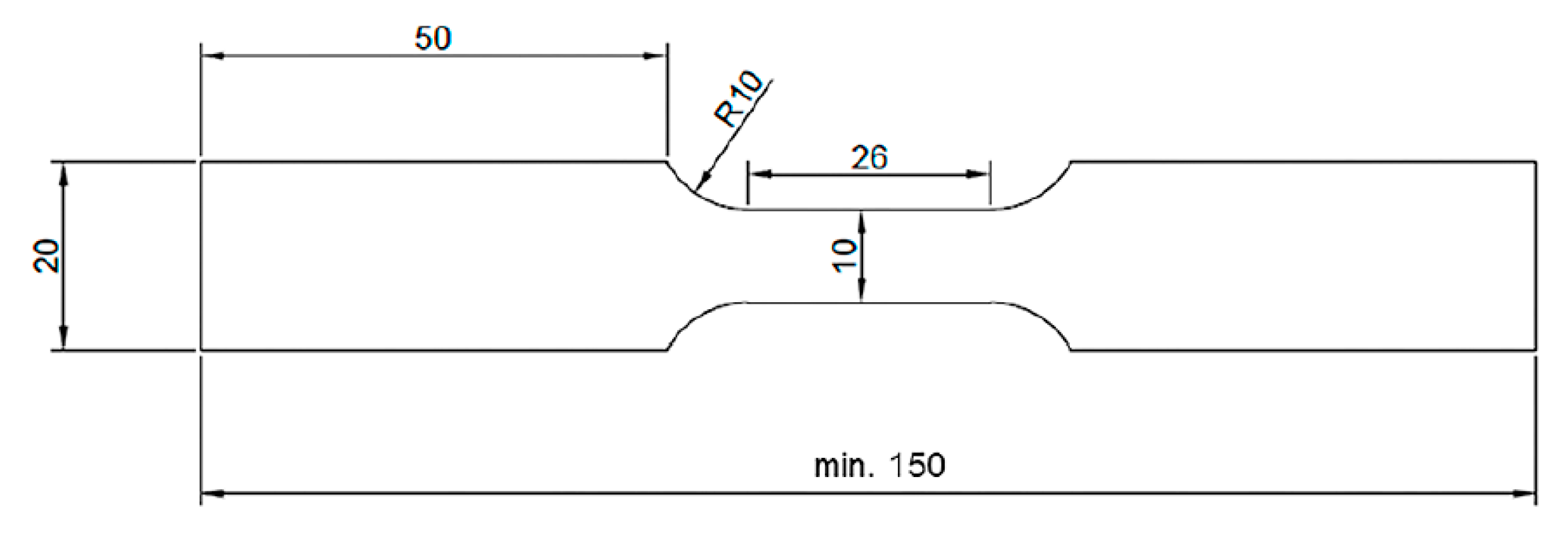
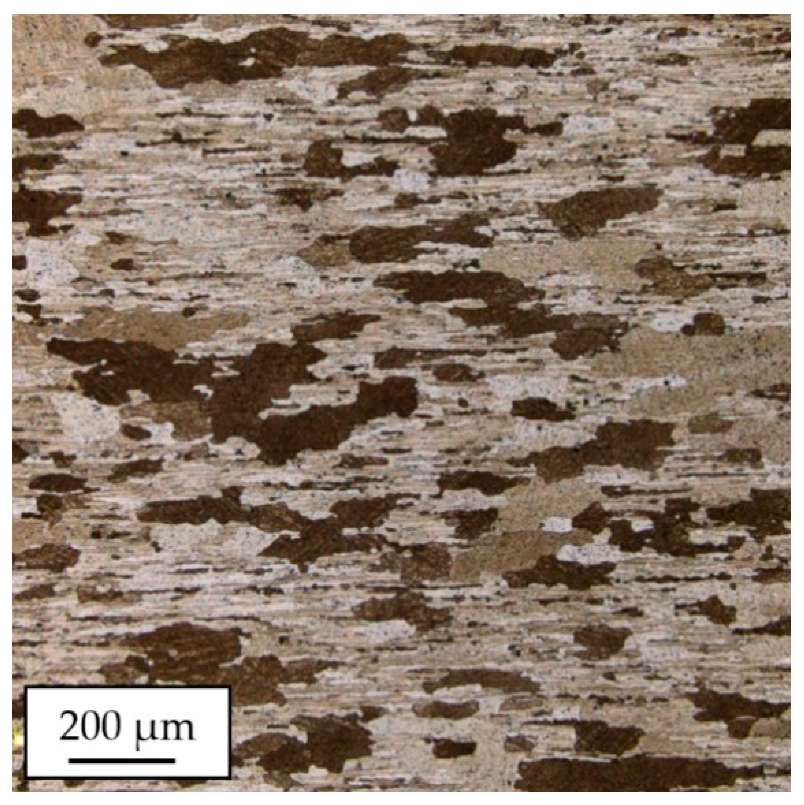
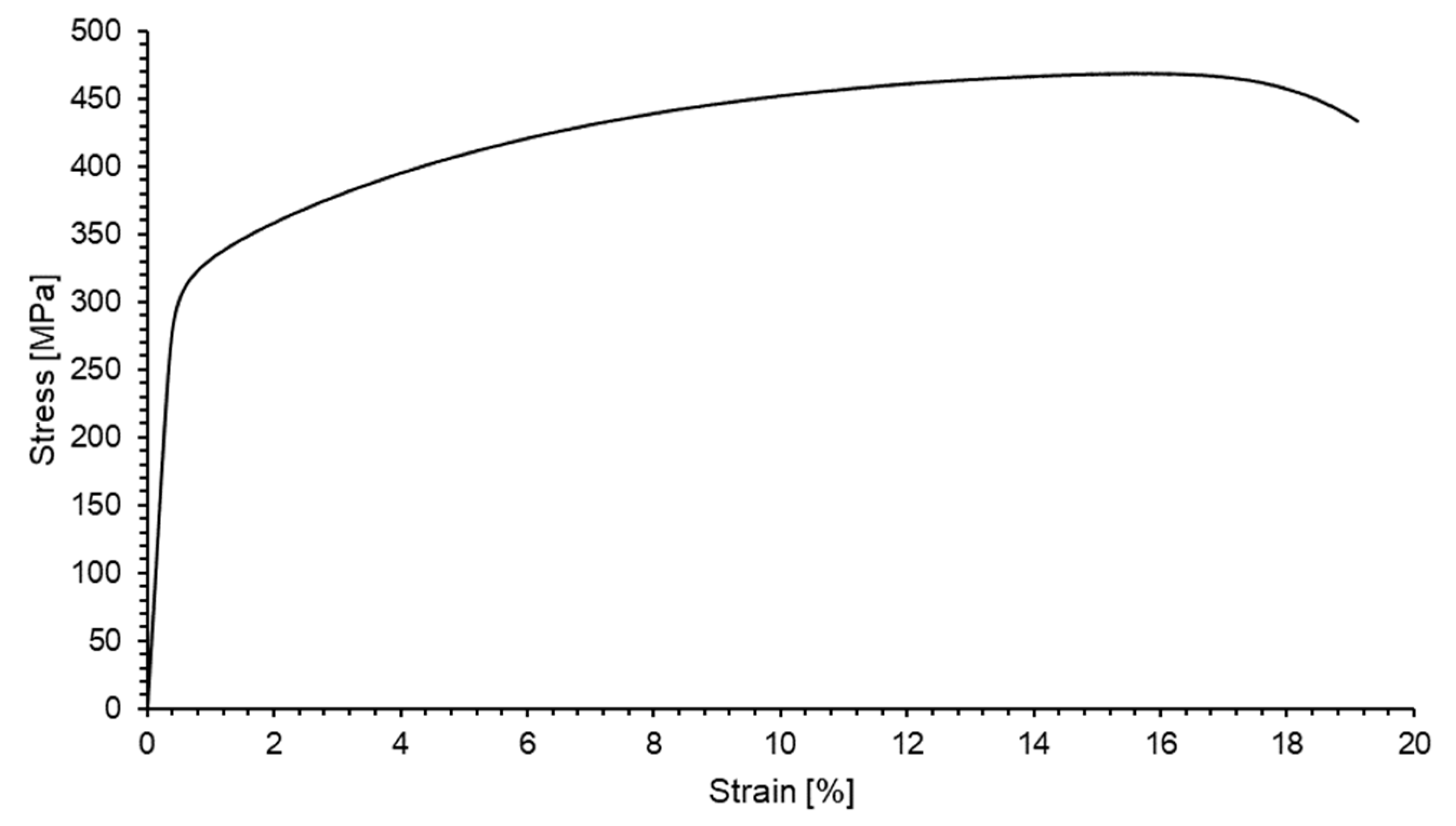
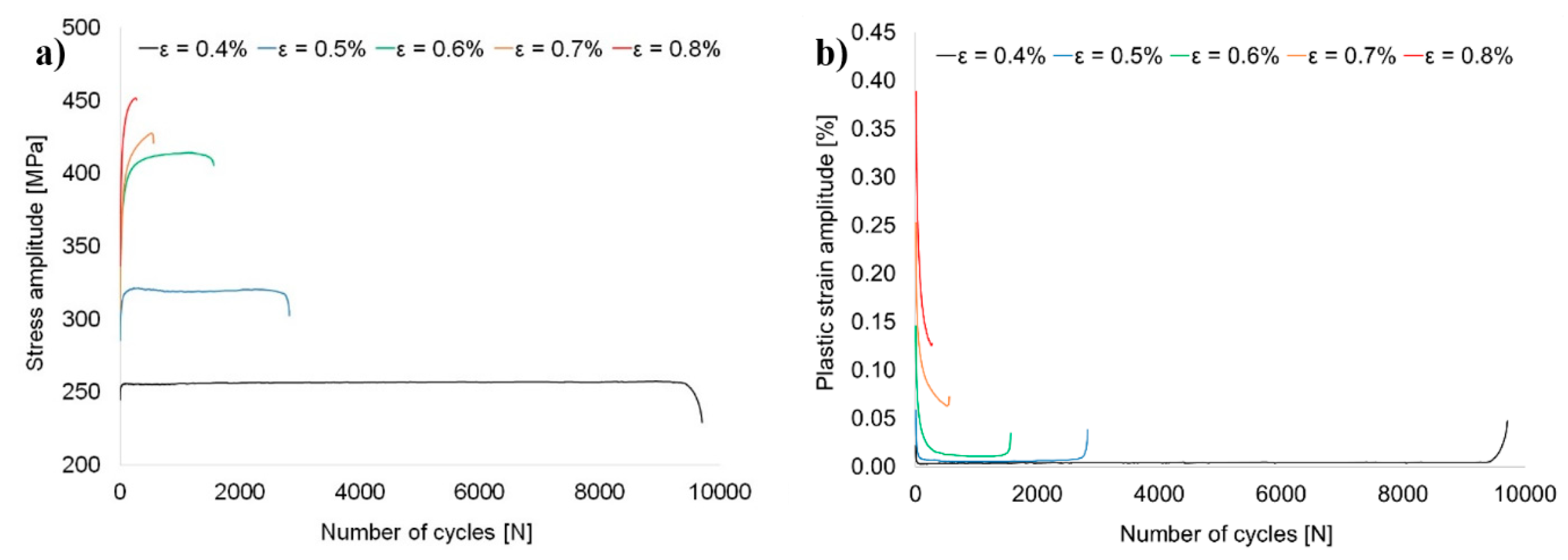


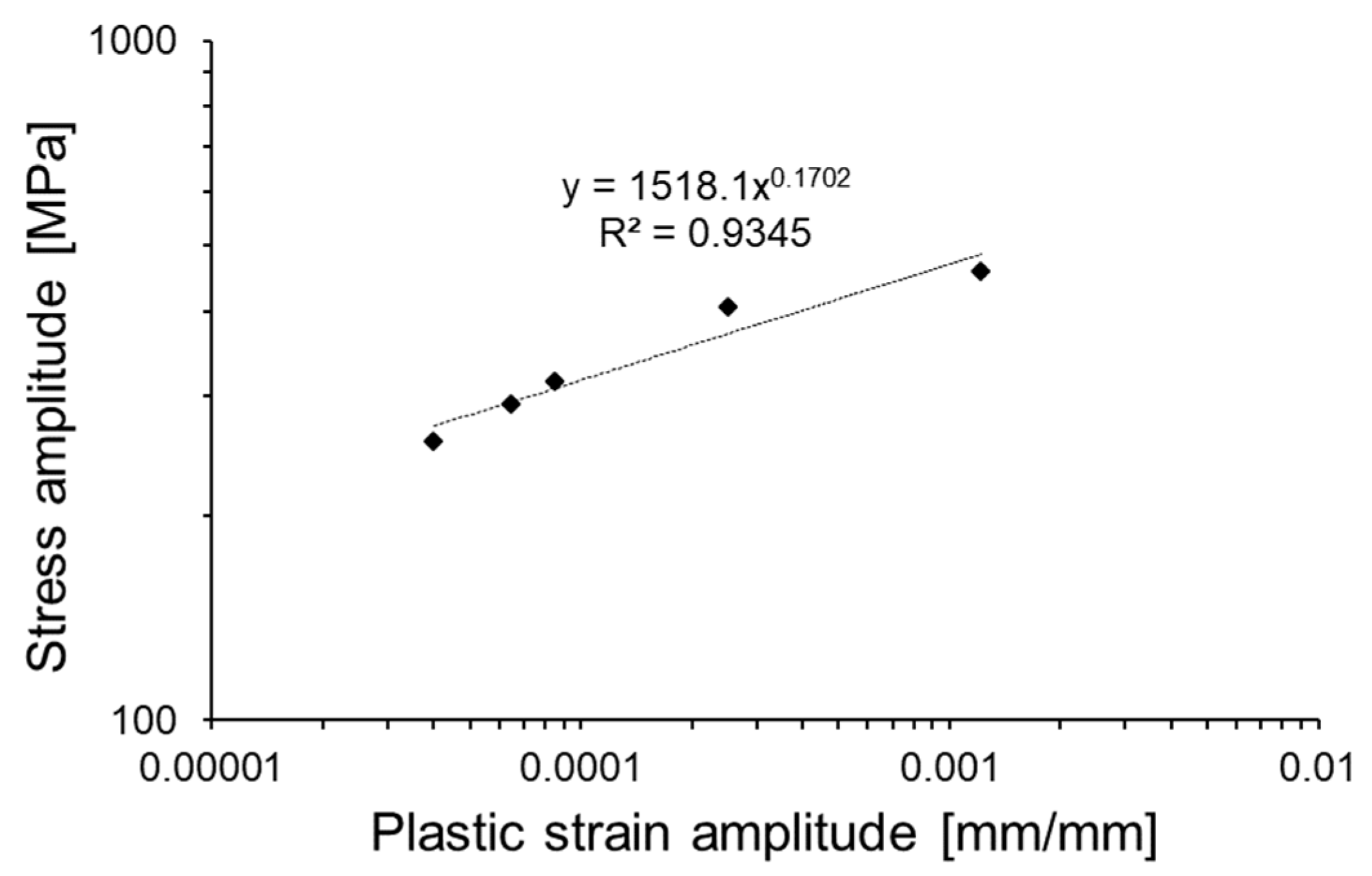
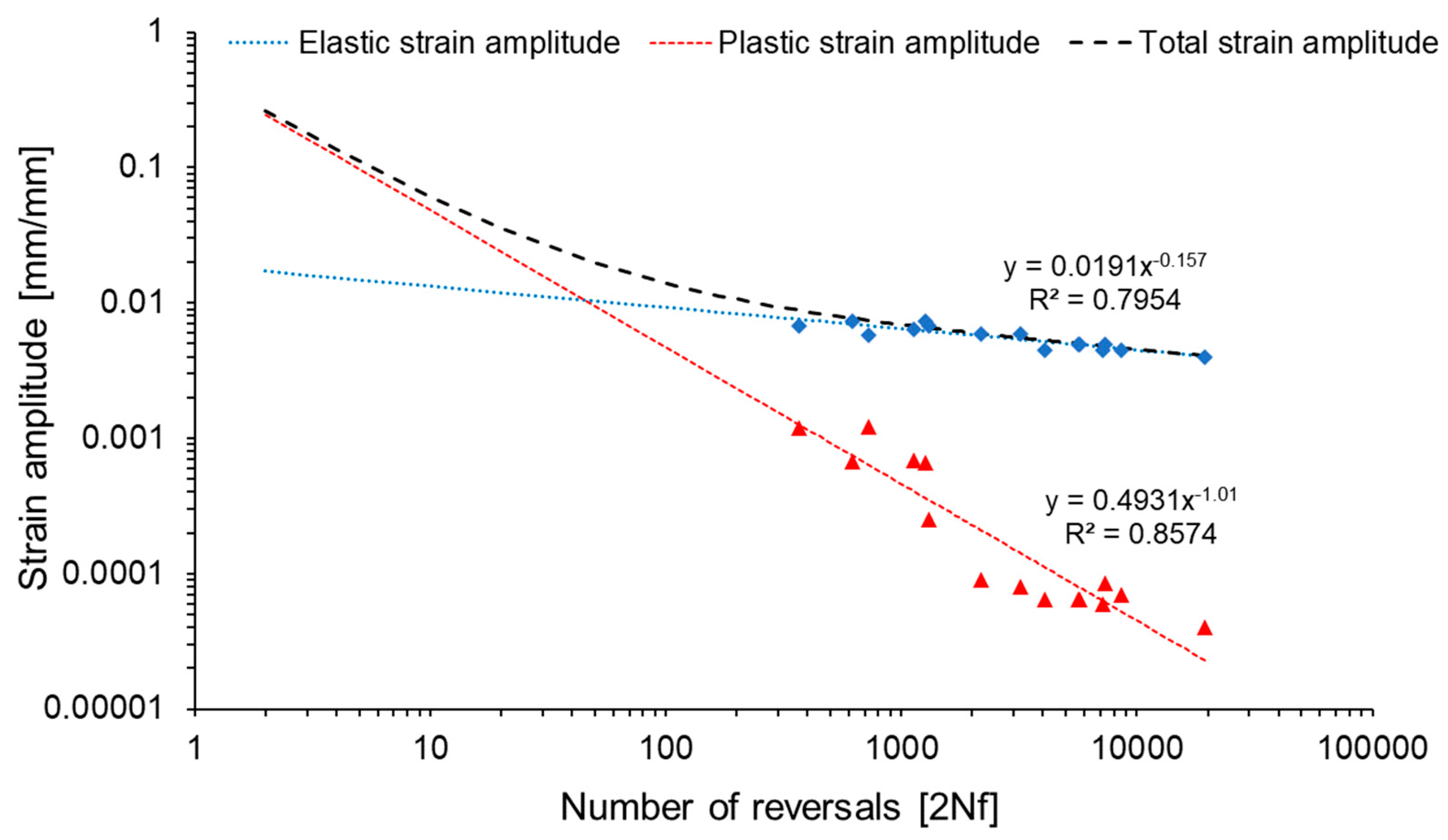
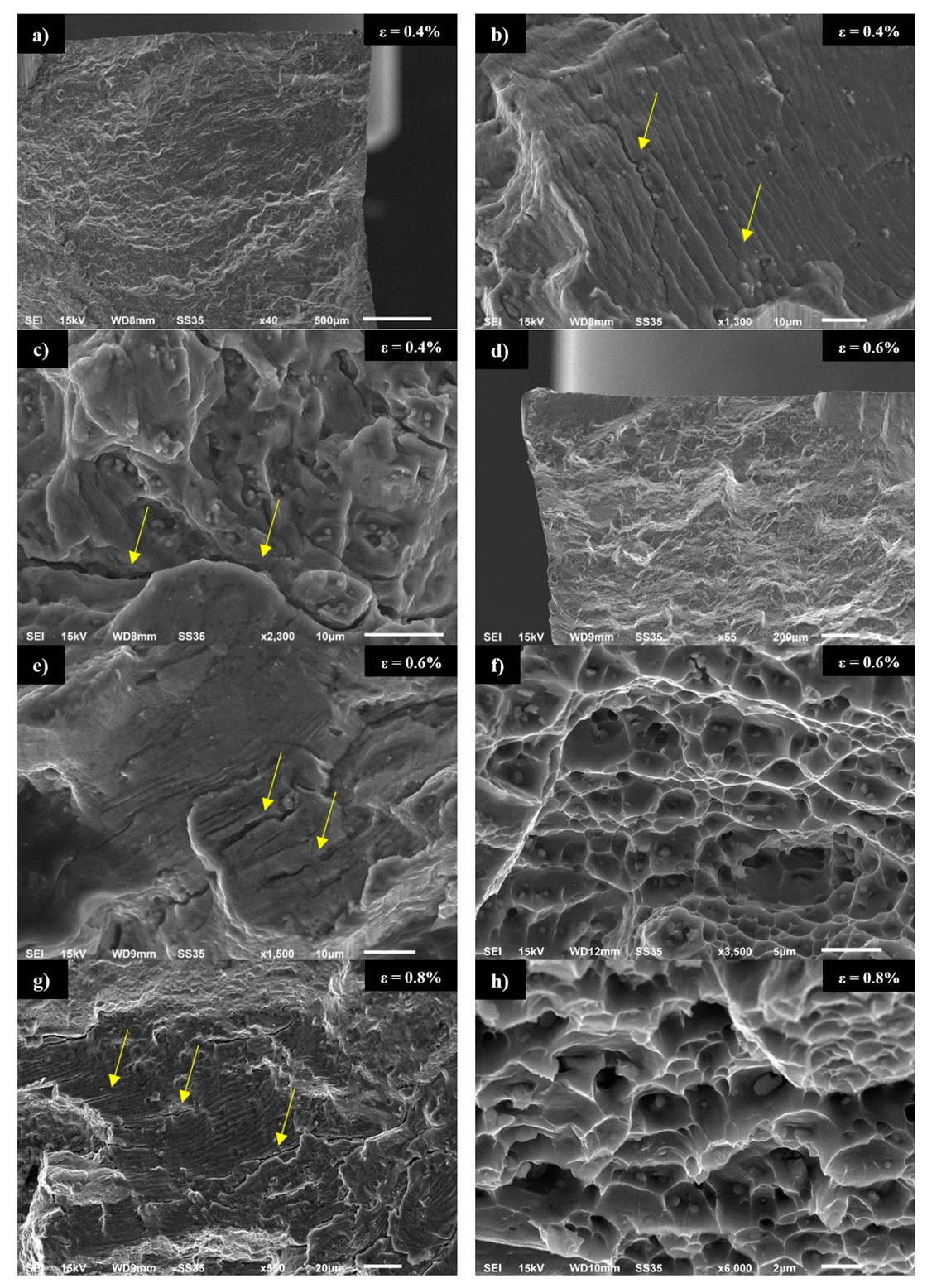
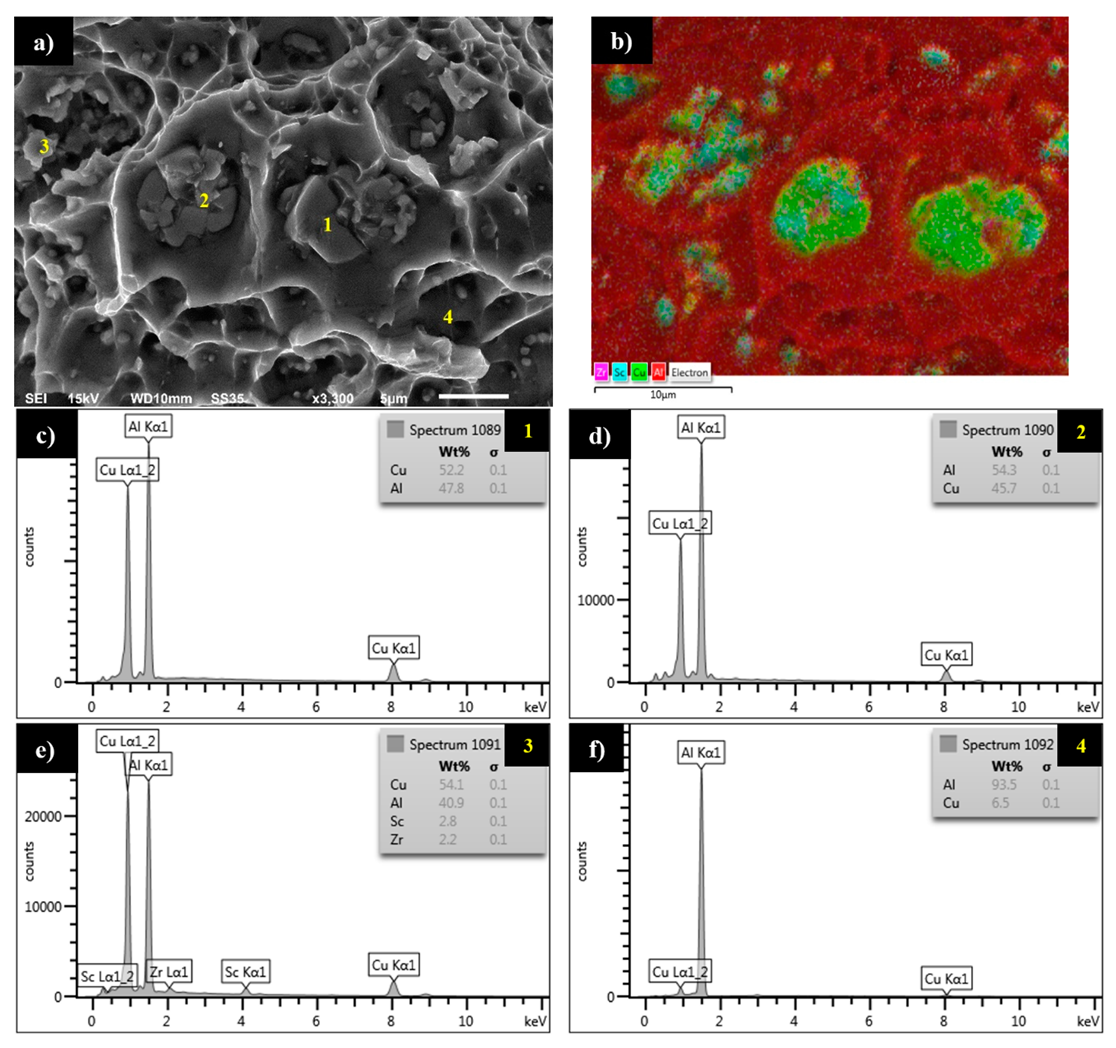
| Fe | Si | Cu | Zn | Ti | Mn | Mg | Ni | Zr | Sc | V | Al |
|---|---|---|---|---|---|---|---|---|---|---|---|
| 0.11 | 0.08 | 6.32 | 0.05 | 0.08 | 0.17 | 0.33 | 0.02 | 0.19 | 0.16 | 0.10 | Base |
| Young Modulus (E) | Yield Strength (Re0,2) | Tensile Strength (Rm) | Fracture Stress (Ru) | Elongation (A) |
|---|---|---|---|---|
| 78 GPa | 312 MPa | 469 MPa | 434 MPa | 19% |
© 2020 by the authors. Licensee MDPI, Basel, Switzerland. This article is an open access article distributed under the terms and conditions of the Creative Commons Attribution (CC BY) license (http://creativecommons.org/licenses/by/4.0/).
Share and Cite
Kosturek, R.; Śnieżek, L.; Torzewski, J.; Wachowski, M. Low Cycle Fatigue Properties of Sc-Modified AA2519-T62 Extrusion. Materials 2020, 13, 220. https://doi.org/10.3390/ma13010220
Kosturek R, Śnieżek L, Torzewski J, Wachowski M. Low Cycle Fatigue Properties of Sc-Modified AA2519-T62 Extrusion. Materials. 2020; 13(1):220. https://doi.org/10.3390/ma13010220
Chicago/Turabian StyleKosturek, Robert, Lucjan Śnieżek, Janusz Torzewski, and Marcin Wachowski. 2020. "Low Cycle Fatigue Properties of Sc-Modified AA2519-T62 Extrusion" Materials 13, no. 1: 220. https://doi.org/10.3390/ma13010220
APA StyleKosturek, R., Śnieżek, L., Torzewski, J., & Wachowski, M. (2020). Low Cycle Fatigue Properties of Sc-Modified AA2519-T62 Extrusion. Materials, 13(1), 220. https://doi.org/10.3390/ma13010220








